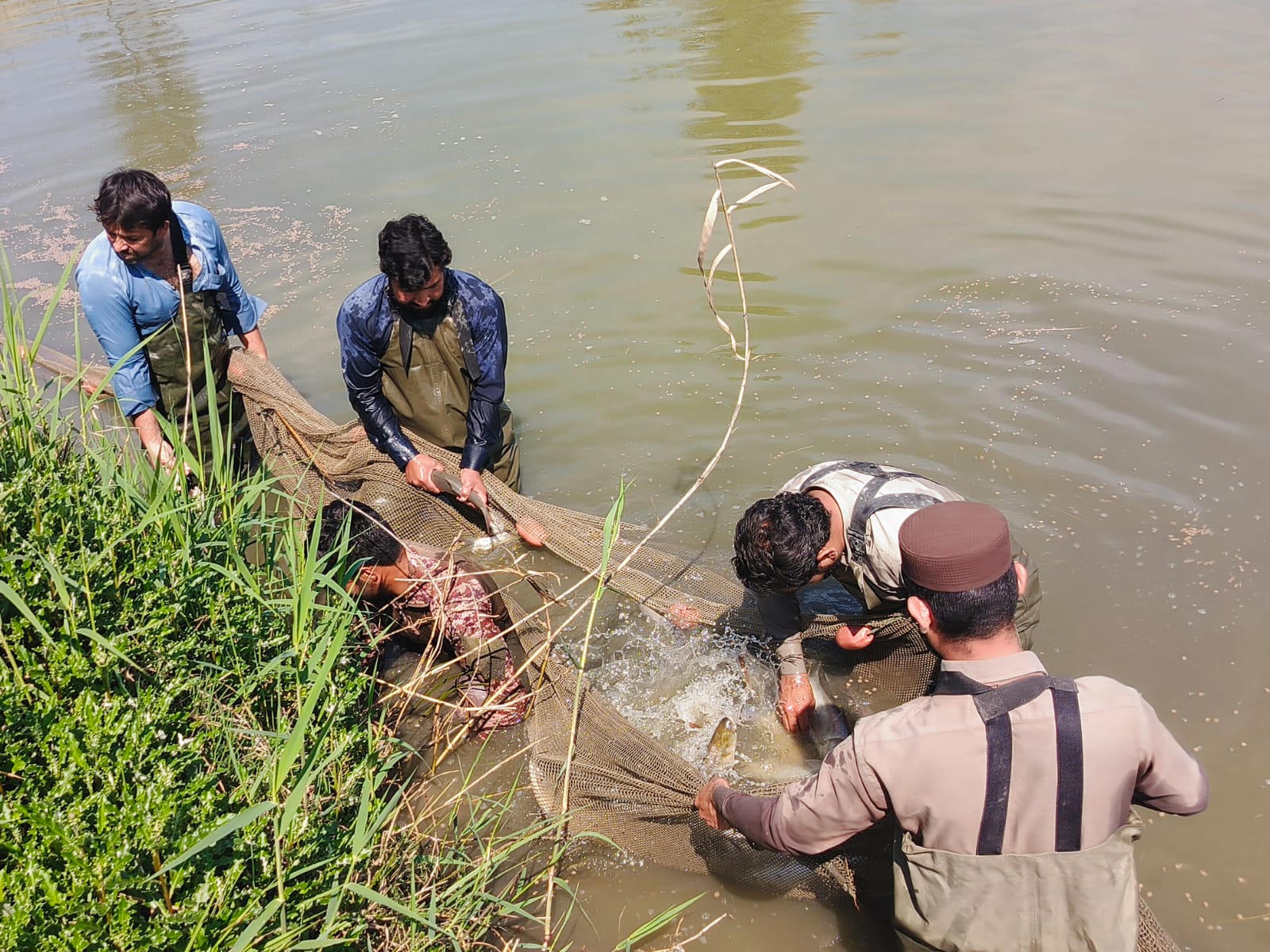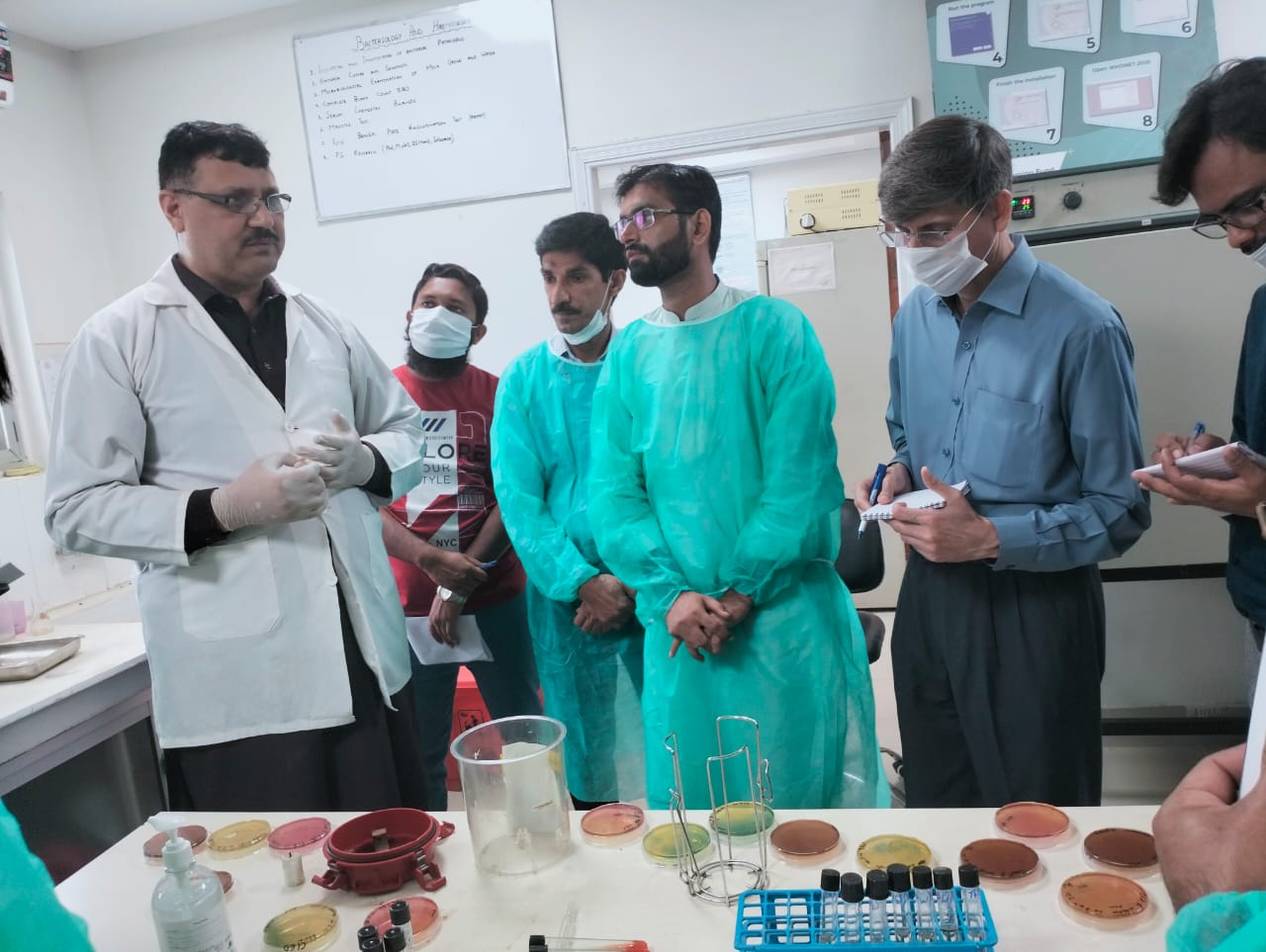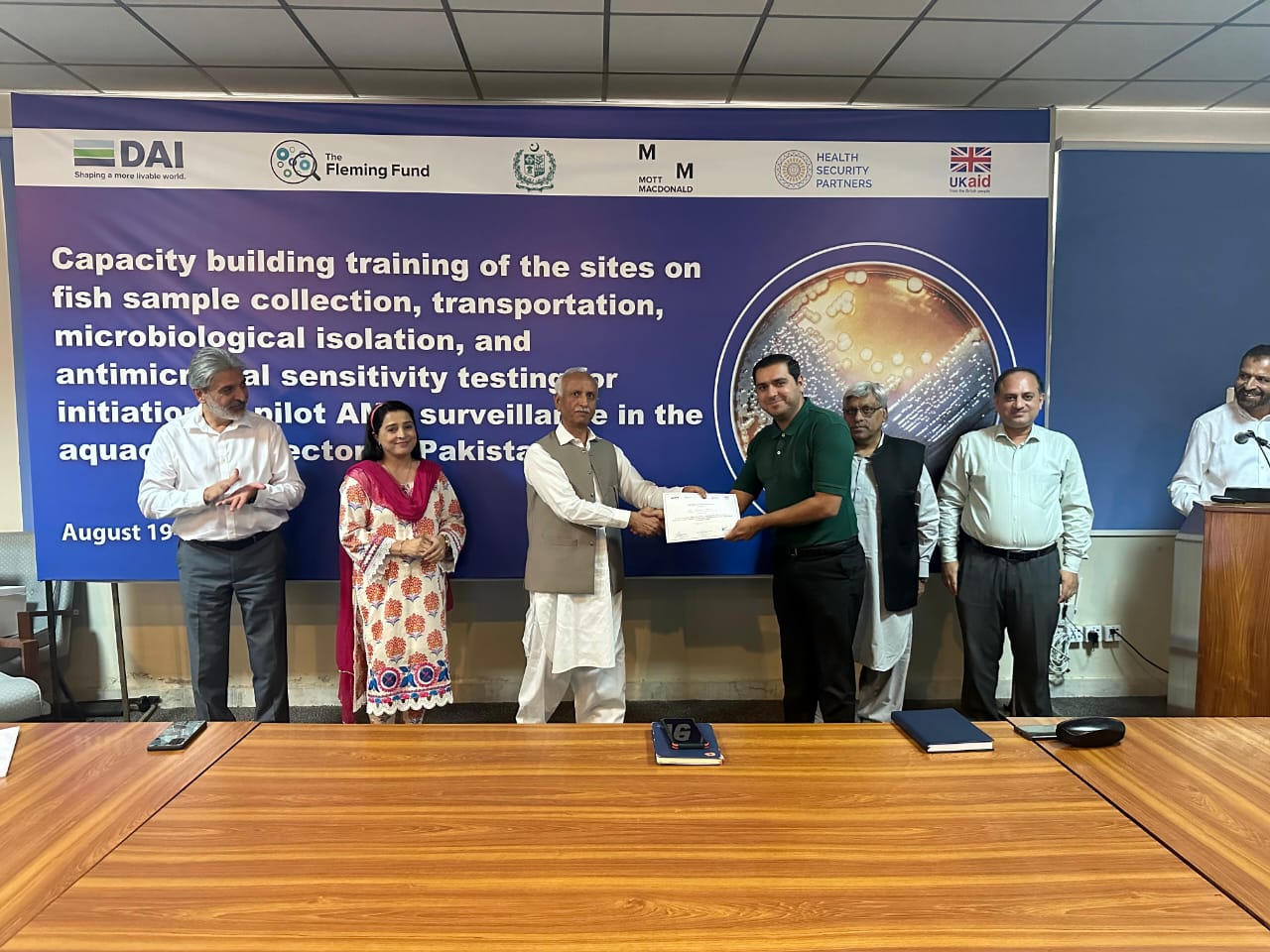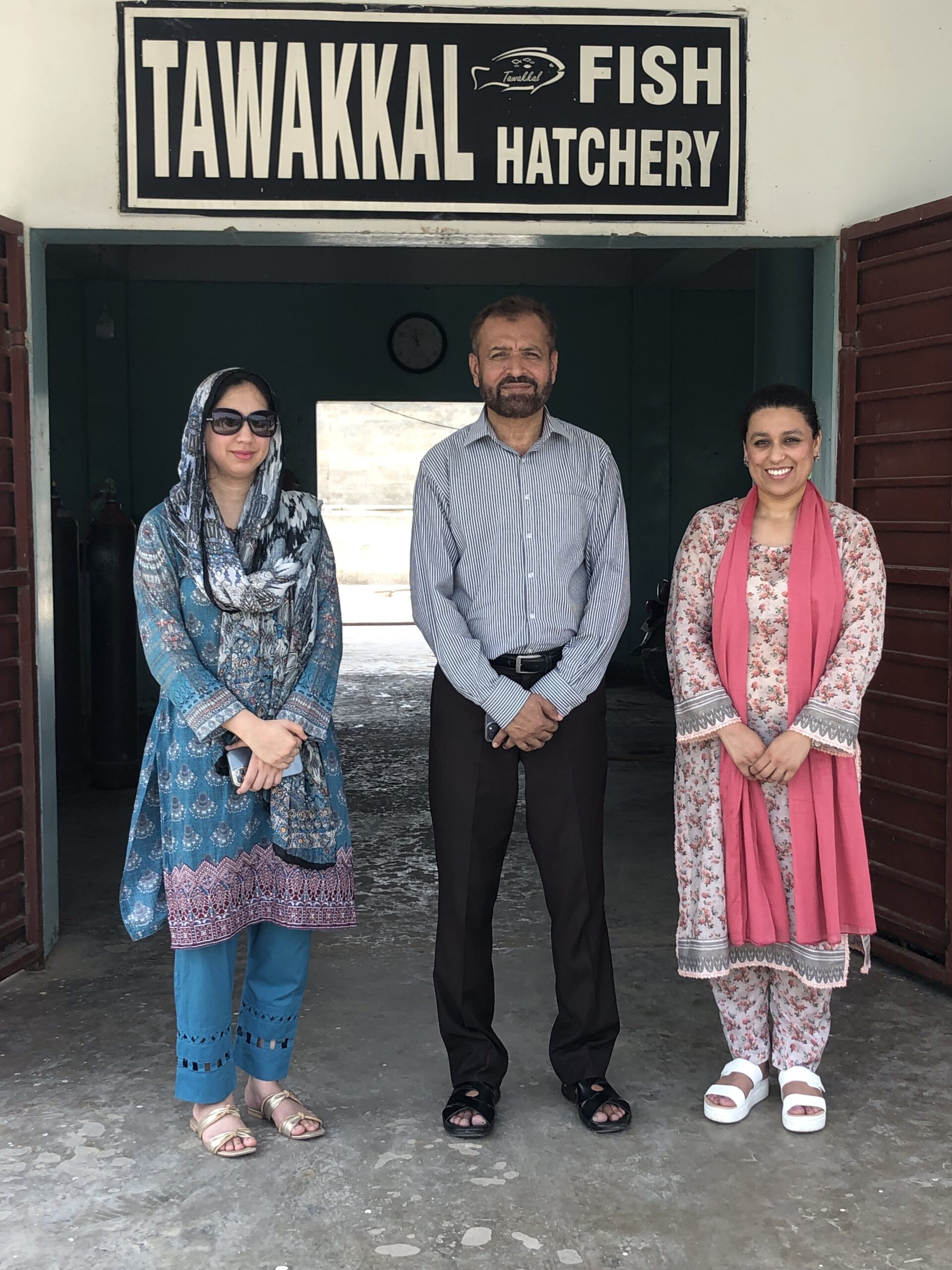Inauguration of upgraded national laboratories, supported by the Fleming Fund, UK Health Security Agency and DAI.
First AMR aquaculture surveillance strategy in Pakistan to safeguard food security
In a significant milestone for antimicrobial resistance (AMR) surveillance in Pakistan, the Fleming Fund Country Grant (FFCG), led by DAI, in collaboration with the Ministry of National Food Security & Research (MoNFS&R), has developed the country’s first ‘National Surveillance Strategy for AMR in Aquaculture’.
The strategy lays the groundwork for systematic AMR monitoring in the sector. The Ministry has launched its pilot AMR surveillance in aquaculture with the support of the FFCG in Pakistan, marking a crucial step towards evidence-based policymaking and improved aquatic animal health management.

Image above shows sample collection at a surveillances site of the Pilot AMR Surveillance in Aquaculture Sector of Pakistan. (Credit: DAI).
Fisheries are vital to Pakistan’s economy, providing essential livelihoods for coastal and land communities. Fish production plays a crucial role in the economy and food security, being a valuable alternative protein source to reduce the reliance on conventional meats (mutton, beef, and poultry).
A considerable number of children experience stunted growth in Pakistan, with over 40% of under-five children being affected. This is often linked to malnutrition, which includes inadequate protein intake and overall energy deficiency from limited access to nutritious food.
The impact of the fisheries sector also extends to employment and sustainable resource management. Between 2023 and 2024, total fish production reached 720.900 metric tonnes (MT), comprising 410.900 MT from marine fisheries and the rest from inland waters (Pakistan Economic Survey 2023-24).
To curtail antimicrobial resistance, a country should have a strong surveillance system for AMR in the veterinary and human sectors, and to undermine the driving forces for the inter-sectoral AMR spread, monitoring in aquaculture and fisheries is equally important.
Dr Qadeer, Team Lead, Fleming Fund Country Grant in Pakistan, DAI.
Aquaculture antimicrobials
Globally, aquaculture is a rapidly growing industry, accounting for almost half of the fish used for human consumption worldwide. Farming practices that maximise fish production volume, but frequent disease outbreaks could occur, often requiring antimicrobial use.
These antimicrobials are usually administered orally to entire populations containing sick, healthy, and carrier fish by a process known as ‘metaphylaxis’. The groups of fish share tanks or cages, in formulated feed, by immersion in closed containers, and occasionally, a bath.
“In the absence of collectors to remove uneaten medicated feed from water, it is estimated that up to 80% of the administered antimicrobial active ingredients remain in the water and sediments in surrounding environments,” Dr Qadeer, Team Lead for the FFGC in Pakistan explained. “Therefore, the aquaculture environment could retain higher antimicrobial concentrations than those in terrestrial animal farming conditions.”
Curtailing drug resistance
The National AMR Surveillance Strategy in Aquaculture was initiated with a consultative workshop conducted by the MoNFS&R in partnership with the FFCG in Pakistan, with aquaculture experts in academia, industry, and government in attendance. This led to the strategy being developed between national and international experts from the Fleming Fund AMR One Health grants and the NGO, World Fish.
The framework for AMR surveillance in aquaculture production guides capacity building, coordination, and technical preparation for the development of programmes to inform public health policymakers. It will also guide the revision of the AMR National Action Plan of Pakistan (2024-2028).

Capacity building of the sites on sample collection, transportation, pathogen isolation and conducting AST in progress at Aquaculture and Fisheries Programme. (Credit: DAI).
Baseline AMR data sharing
The strategy enables the establishment of baseline data on the prevalence of resistant microorganisms, strengthening of AMR surveillance components, and genomic analysis for isolated bacteria in aquaculture.
Provincial and academic institute fisheries departments, Aquaculture and Fisheries Program NARC, Fisheries Development Board, aquaculture farmers, donor agencies, and other relevant stakeholders were consulted.
The strategy identifies the following objectives for the surveillance of AMR in aquaculture:
- The level of bacterial pathogens and their resistance to antimicrobials in select aquatic species raised in various aquaculture production systems.
- Build AMR surveillance system capacities for the aquaculture sector, including epidemiological design (sampling frame, size calculation, and methodology), sample transportation, laboratory processing, and quality data production.
- Contribute aquaculture AMR data into the National AMR surveillance system, and potentially, contribute to global AMR data.
- Provision of policy guidelines to the concerned authorities based on AMR data in the aquaculture of Pakistan.

Training in capacity building of the surveillance sites on sample collection, transportation, pathogen isolation and conducting AST, at the National Veterinary Laboratory. (Credit: DAI).
AMR knowledge gap
AMR data from aquaculture production in Pakistan is a knowledge gap in understanding the transmission of zoonotic and foodborne pathogens across the One Health domains (environment, animals, humans).
“Data from aquatic animals contributes to the ‘state of science’ on AMR in Pakistan and integrated AMU/AMR surveillance initiatives, and could be used for further studies, including risk analysis of foodborne and zoonotic bacteria from aquatic animals, source attribution and microbial source tracking,” said Dr Qadeer.
Pilot AMR surveillance is being conducted in Pakistan to enable the government to monitor and track AMR trends in economically important fish species. A Policy Brief of the results will allow knowledge sharing and guide advocacy for government endorsement, policy change, and the integration of AMR protocols into national guidelines.

Certificate awarding session on successful completion of the aquaculture AMR surveillance training.
From the ground up
Dr Usman Ayaz, Assistant Animal Husbandry Commissioner at the Ministry of National Food Security and Research in Islamabad, said how the pilot study, aligned with the National AMR Surveillance Strategy, is being implemented nationwide with public and private sector collaboration, focusing on three key species: Trout, Tilapia, and Rohu.
“The FFCG facilitated this unique partnership with private stakeholders, notably farmers, who lead Pakistan’s inland fish production, adding critical value. The findings will guide MoNFS&R in understanding AMR patterns in this burgeoning but rapidly growing food production industry.”
Dr Anum Hadi, Surveillance Coordinator of the FFCG in Pakistan, added: "With Pakistan’s aquaculture sector on the rise, we seized a critical opportunity: to embed AMR surveillance from the ground up. By forging public-private alliances, this landmark strategy empowers farmers and researchers alike to monitor AMR in E. coli and Aeromonas (normal flora of healthy fish). This initiative advances both AMR containment and food security and reinforces One Health through practical, cross-sectoral action."

Visit to a private sector farm enrolled in the Pilot AMR Surveillance in Aquaculture. (Credit: DAI).
More Like This
Programme Update
From Programme Update, Celebrating a new milestone in the UK-Pakistan partnership to tackle AMR and strengthen health systems , Date: 27/06/2022
Studies & Reports
From Studies & Reports, Case Study: Pakistan’s first ‘antibiotic footprint’ analysis , Date: 09/08/2024
Just like our carbon footprint monitors the global environmental impact of harmful greenhouse gases, we also need to track our antibiotic footprint to contain and reduce the effects of drug resistance.